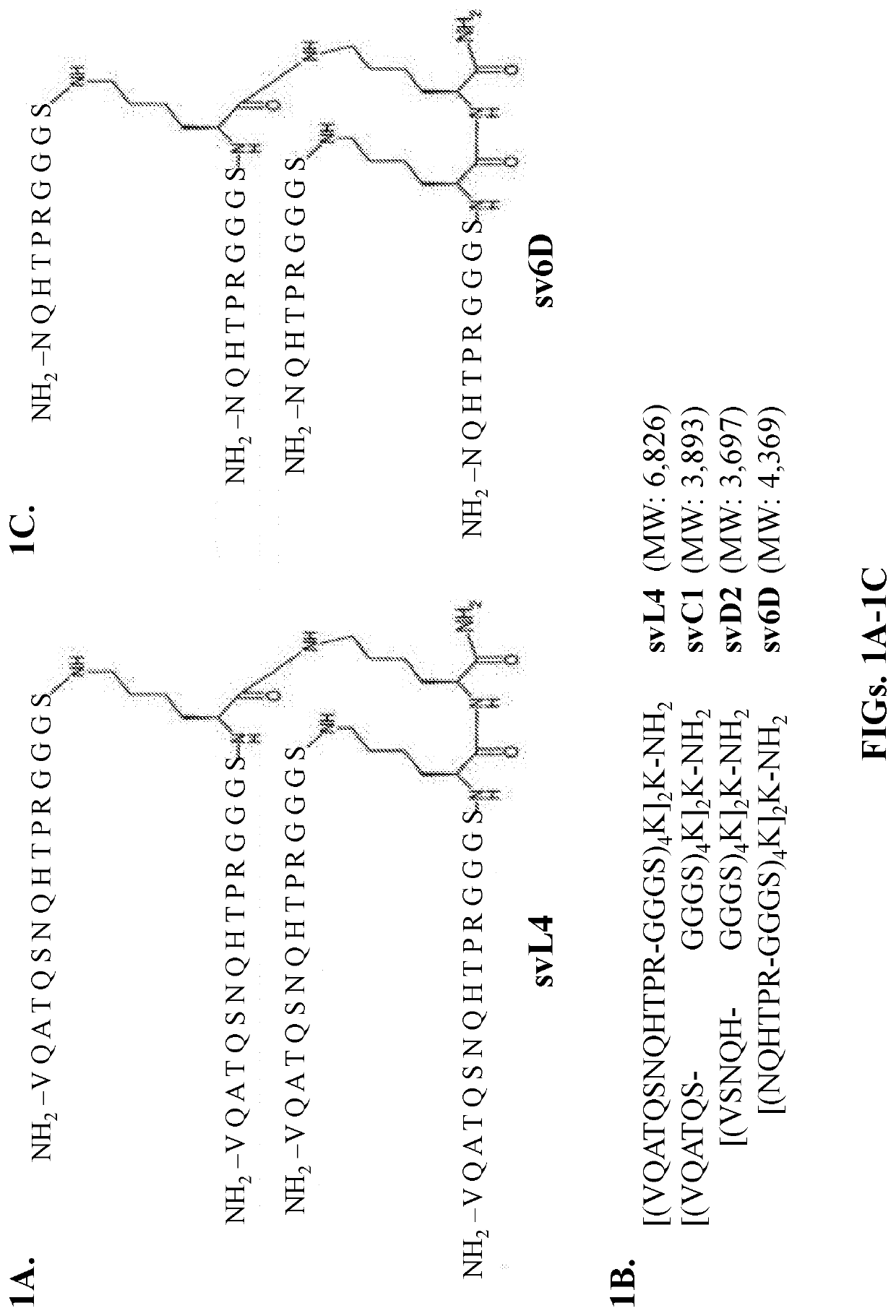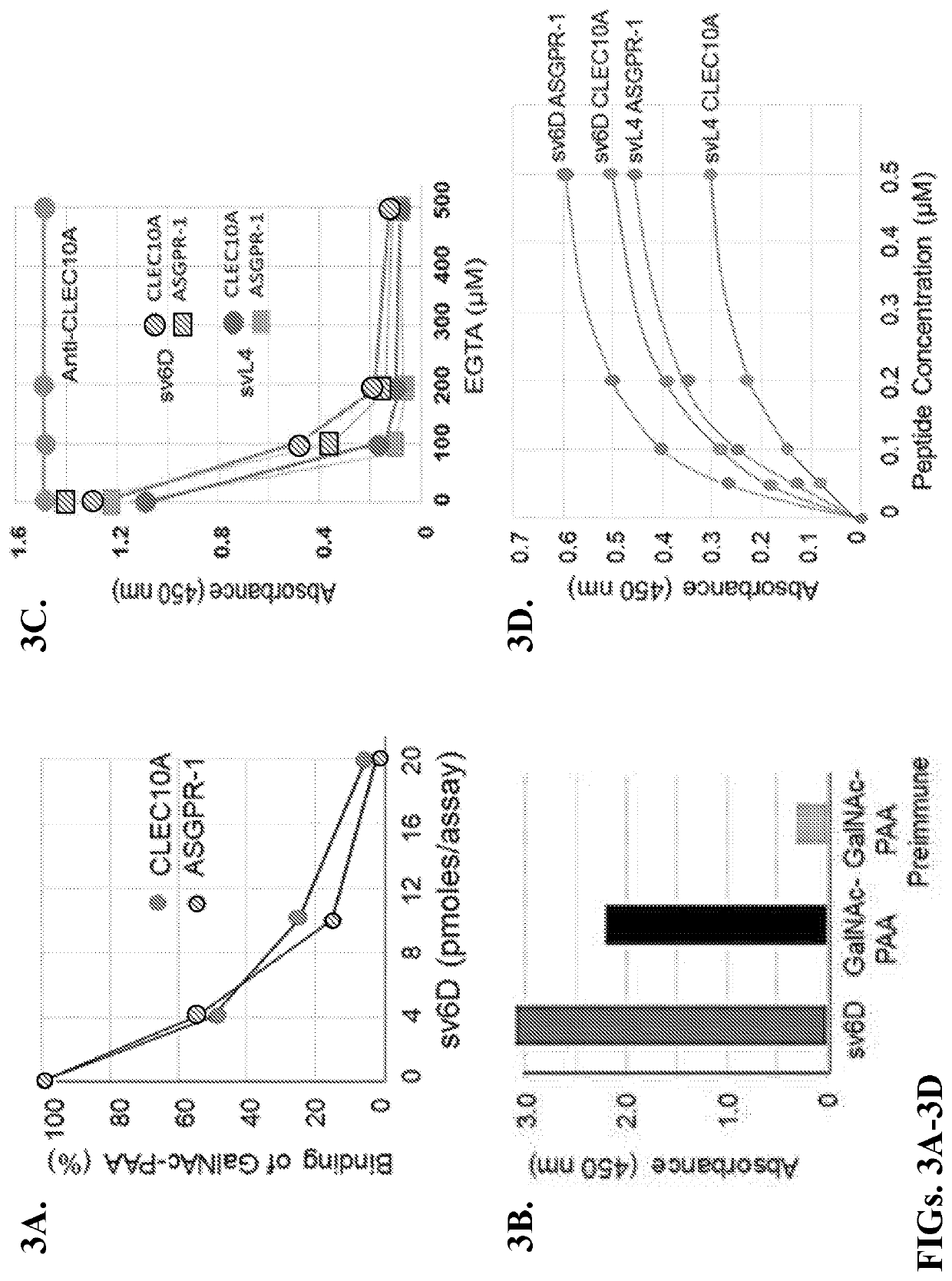Compositions and methods of treating cancer with glycomimetic peptides
a glycomimetic peptide and cancer technology, applied in the field of compositions comprising therapeutic peptides, can solve the problems of drug resistance, toxicity of treatment agents against cancer, and gradual dissipation of drug effectiveness, and achieve the effect of effective anticancer agents and greater efficacy
- Summary
- Abstract
- Description
- Claims
- Application Information
AI Technical Summary
Benefits of technology
Problems solved by technology
Method used
Image
Examples
example 1
[0096]Synthesis of peptides Functional sequence of svL4 was identified through a screen of a 12-mer phage display library (New England BioLabs, Ipswich, Mass.) with the GalNAc-specific lectin from the snail Helix pomatia [60, 111]. The consensus sequence was incorporated into a tetravalent structure based on the concept of avidity of binding to receptors as a function of ligand density and entropic factors [44, 49, 112-114]. Multivalent peptides were synthesized by standard solid-phase chemistry utilizing Fmoc (9-fluorenylmethoxycarbonyl)-protected amino acids by CBL Biopharma LLC (Patras, Greece). The tri-lysine ‘core’ was synthesized on the solid-phase resin and extended with the sequence GGS. The ‘arms’ with C-terminal G were synthesized separately by standard chemistry and condensed in solution with the core [115]. Modifications at the C-terminus consisted of an amide group (no tag) or extensions with ε-biotinyl-lysinyl-amide. The sequence GGGS (SEQ ID NO: 3) was included in the...
example 2
o Recombinant Receptors
[0104]Solid-phase binding assays were performed with recombinant human receptors. Three variations of the binding assay were used in this study, all of which allowed the arms of the tetravalent peptide to have full flexibility. (i) Biotinylated peptide was bound in microtiter wells coated with streptavidin and incubated with recombinant human receptors. After extensive washing, the bound receptor was measured by peroxidase conjugated to a receptor-specific antibody. (ii) The extracellular domains of receptors, which were fused with the Fc domain of immunoglobulin IgG, were bound in wells coated with protein A / G. Biotinylated peptide was incubated with the receptors and, after extensive washing, bound peptide was measured with streptavidin conjugated with peroxidase. Or (iii), recombinant receptors with a poly-His tag were bound to Nickel-coated wells and incubated with biotinylated peptide. svL4 and sv6D contain His residues (FIGS. 1A, 1C) and can bind to the ...
example 3
Modeling of Peptides as Mimetics of GalNAc
[0110]Extensive characterization studies demonstrated that the peptide sv6D is a bona fide mimetic of GalNAc. Moreover, sv6D bound strongly to the GalNAc-specific receptors CLEC10A and ASGPR-1 (FIGS. 3A-3D). To investigate further its ability to bind to human GalNAc-specific lectins, in silico molecular modeling was performed. Whereas the crystal structure of CLEC10A has not been reported, that of ASGPR-1 (CLEC4H1) was determined [12]. The extensive homology between CLEC10A and ASGPR-1 allowed generation of a likely structure for CLEC10A with SWISS-MODEL Deep View [106,107]. The CABS-dock modeling program [105] was used to predict whether the peptide would bind to ASGPR-1 and CLEC10A. This method searches for a binding site on the protein without prior assignment and defines the most probable peptide conformation. The docking program accommodated svL4 in the carbohydrate-recognition domain (CRD) in a hair-pin conformation (RMSD=0.868 Å).
[011...
PUM
| Property | Measurement | Unit |
|---|---|---|
| wavelengths | aaaaa | aaaaa |
| time | aaaaa | aaaaa |
| time | aaaaa | aaaaa |
Abstract
Description
Claims
Application Information
 Login to View More
Login to View More - R&D
- Intellectual Property
- Life Sciences
- Materials
- Tech Scout
- Unparalleled Data Quality
- Higher Quality Content
- 60% Fewer Hallucinations
Browse by: Latest US Patents, China's latest patents, Technical Efficacy Thesaurus, Application Domain, Technology Topic, Popular Technical Reports.
© 2025 PatSnap. All rights reserved.Legal|Privacy policy|Modern Slavery Act Transparency Statement|Sitemap|About US| Contact US: help@patsnap.com



